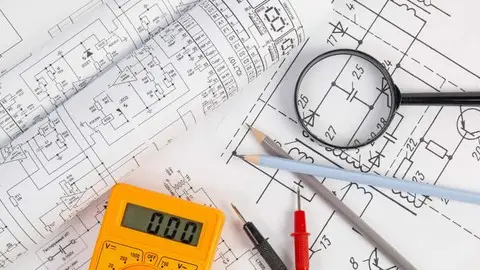Mastering Schematics Electrical Drawings Episode 1
Published 8/2023
MP4 | Video: h264, 1280x720 | Audio: AAC, 44.1 KHz
Language: English | Size: 721.64 MB | Duration: 2h 21m
Published 8/2023
MP4 | Video: h264, 1280x720 | Audio: AAC, 44.1 KHz
Language: English | Size: 721.64 MB | Duration: 2h 21m
Learn from Professionals, Electrical Power Engineering, Wiring Diagram of Electrical Panel
What you'll learn
Basics of Schematics
MCB
Auxiliary Relays
Contactors, CT circuit , NO, NC , Change over contact
Requirements
Basics of electrical engineering
Description
Unlock the world of electrical drawings and schematics with our comprehensive online course. Designed for beginners and enthusiasts in electrical engineering, this course dives deep into understanding and interpreting electrical diagrams. From the basics of MCBs to advanced concepts like auxiliary relays and current transformers, you'll gain the knowledge and skills needed to confidently navigate and create electrical schematics.Course Outline:Module 1: Introduction to Electrical DrawingsUnderstanding the significance of electrical drawings in engineering projects.Overview of symbols and conventions used in electrical schematics.Module 2: Mini Circuit Breakers (MCBs)Exploring different types: Single pole, Two pole, and Three pole MCBs.Visualizing MCBs in drawings and their representations.Auxiliary contacts: Their role and importance in MCB applications.Module 3: Contact Types and SymbolsDecoding normally open (NO) and normally closed (NC) contacts.Unraveling the working of auxiliary relays and their use in panel wiring.Diving into time-delayed contacts and the significance of changeover contacts.Module 4: AC Socket Symbol and DrawingUnderstanding the AC socket symbol in electrical schematics.Demonstrating how to incorporate AC sockets in drawings.Module 5: Terminal Blocks and FerrulesIntroduction to terminal blocks and their relevance in electrical installations.Learning how to depict terminal blocks in drawings.Exploring ferrules and mastering the art of addressing them effectively.Module 6: Magnetic ContactorsDifferentiating between auxiliary relays and magnetic contactors.Understanding the unique functionalities of magnetic contactors.Module 7: Current Transformers (CTs)Defining the role and significance of current transformers.Unveiling the circuitry associated with current transformers.Module 8: Putting It All TogetherPractical exercises and examples to reinforce your learning.Creating your own simplified electrical schematic incorporating the concepts covered.Course Benefits:Gain a solid understanding of electrical drawings and schematics.Enhance your ability to interpret and create accurate electrical diagrams.Grasp the functions of components like MCBs, auxiliary contacts, and CTs.Learn through interactive exercises and real-world examples.Obtain a course completion certificate to showcase your expertise.Join us on this illuminating journey through electrical drawings and schematics. Master the art of reading and creating accurate diagrams that are the backbone of electrical engineering projects. Enroll today and open the door to a world of electrical expertise!
Overview
Section 1: Introduction
Lecture 1 Introduction
Section 2: Single Pole MCB
Lecture 2 Single Pole MCB
Section 3: Two pole MCB
Lecture 3 Two pole MCB
Section 4: Two pole MCB in Schematics
Lecture 4 Two pole MCB in Schematics
Section 5: Three Pole MCB
Lecture 5 Three Pole MCB
Section 6: Aux Contacts of MCB
Lecture 6 Aux Contacts of MCB
Section 7: Auxiliary Contacts of MCBs in drawings
Lecture 7 Auxiliary Contacts of MCBs in drawings
Section 8: Concept of NO and NC contacts
Lecture 8 Concept of NO and NC contacts
Section 9: Learning MCB Schematics
Lecture 9 Learning MCB Schematics
Section 10: AC Socket
Lecture 10 AC Socket
Section 11: Auxiliary Relay
Lecture 11 Auxiliary Relay
Section 12: Auxiliary Relays Function example
Lecture 12 Auxiliary Relays Function example
Section 13: Auxiliary Relay Workign Principle
Lecture 13 Auxiliary Relay Working Principle
Section 14: Basic Types of Aux Contacts
Lecture 14 Basic Types of Aux Contacts
Section 15: Auxiliary Contacts part 2
Lecture 15 Auxiliary Contacts part 2
Section 16: Time Delayed Contacts
Lecture 16 Time Delayed Contacts
Section 17: Change Over Contact
Lecture 17 Change Over Contact
Section 18: Terminal Block
Lecture 18 Terminal Block
Section 19: Magnetic Contactors
Lecture 19 Magnetic Contactors
Section 20: Understanding the Current Transformer Circuit
Lecture 20 Understanding the Current Transformer Circuit
Technicians, Engineers, Students



